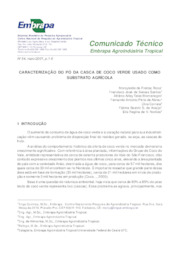Beneficiamento da casca de coco verde para a produção de fibra e pó
Processing of green coconut shells for the production of fiber and powder

Photo: Noroes, Claudio
The development of alternatives for the processing of green coconut shells helps reduce the inadequate disposal of solid waste and provides a new income option for production sites. The green coconut shell processing technology was developed by Embrapa Tropical Agroindustry, in partnership with steel mill FORTALMAG, and can be implemented in all coconut producing areas in the domestic territory.
It is estimated that Brazil has an area of 100,000 hectares planted with dwarf coconut palm, aimed at producing fresh fruit for coconut water consumption. The shells generated by such agribusiness activity represent 80% to 85% of the fruit's gross weight, and about 70% of all the waste generated in Brazilian beaches comprises green coconut shells. This material has been currently assigned to landfills and cesspools and, like any other organic matter, potentially emits greenhouse gases (methane) and contributes to reducing the useful life of such deposits, proliferating foci of disease vectors, foul smell, possible contamination of the soil and water bodies, as well as to the eventual destruction of the urban landscape.
The process of obtaining powder and fiber is performed mechanically, with the use of a set of equipment developed in partnership with the Fortalmag steel mill. Coconut powder is a biodegradable, renewable, light material that is quite similar to the best Sphagnum moss found in the Northern Europe and North America. It provides an advantageous physical structure, with high porosity and high potential for moisture retention, which favors the physiological activity of roots. It can be used as an ingredient for the formulation of agricultural substrata and organic composts. The fiber can be used as raw material for arts and crafts, to manufacture plant pots and dishes as a tree fern replacement, to pad car seats, and to manufacture of erosion control blankets, which can be used to prevent landslides on hillsides or degraded areas and in interior decoration.
Who benefits from it
Businesspeople from the coconut water bottling sector or who wish to set up a coconut shell processing unit. There will also be positive impacts for the environment, considering the reuse of a material that would be discarded into nature; processing could generate jobs and income for associations and agroindustries.
Geographic range
Coastal areas from Ceará to São Paulo. The production of dry coconut powder has mostly been concentrated in Pará and Bahia, while green coconut powder is decentralized and spreads through the entire territory.
Economic and social benefits
In 2012, twelve units were operating in the whole country with an average processing volume of 10 tons of shells/day, a total added value of over R$ 7.7 million per year.
Each implemented unit represented the creation of an average of 5 jobs to operate the factory and, at a smaller scale, the creation of posts for technicians at secondary school or higher education level, to conduct the businesses in general. The origin of the new employees is mostly local, and some, regional. The number of job posts generated in the 16 companies in operation is about 112; 80 directly in production activities and 32 in technical/administrative activities.
The proliferation of green coconut shell processing units is closely related to the environmental cause. Three processing units evaluated by Embrapa work with shells collected from the urban zones of the cities where they are located (originated from fresh fruit consumption). In the neighborhoods of these units, the impact on reducing waste is noticeable: each unit removes an average of about 5,000 coconut shells per day from urban environments.
Partners
FortalMag, World Bank
Where to find:
Embrapa Agroindústria Tropical
Rua Dra. Sara Mesquita, 2270 – Bairro Pici
CEP 60511-110
Fortaleza - Ceará
Telefone: (85) 3391-7100
Fax: (85) 3391-7109
E-mail: https://www.embrapa.br/fale-conosco/sac/
https://www.embrapa.br/agroindustria-tropical
Process: To obtain fertilizer, corrective, remineralizer, substratum Launch year: 2004
Country: Brazil Region: Central-West, Northeast, Southeast State: Distrito Federal, Goiás, Mato Grosso, Mato Grosso do Sul, Alagoas, Bahia, Ceará, Maranhão, Paraíba, Pernambuco, Piauí, Rio Grande do Norte, Sergipe, Acre, Amapá, Amazonas, Pará, Rondônia, Roraima, Tocantins, Espírito Santo, Minas Gerais, Rio de Janeiro, São Paulo, Paraná, Rio Grande do Sul, Santa Catarina Biome: Amazon Rainforest, Cerrado, Atlantic Rainforest, Caatinga, Pampa, Pantanal
Responsible Unit: Embrapa Tropical Agroindustry
Participating Units: Embrapa Tropical Agroindustry
Keywords: casca, pó, coco verde, Cocos nucífera, beneficiamento, fibra, resíduo, Página Grandes Contribuições


